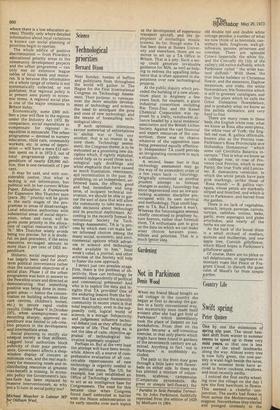Country Life
Swift spring
Peter Quince
• One by. one themilestones of spring slip past. The usual hesitant shift from winter to summer seems to speed up in these very mild years, so that one is less aware of the small landmarks along the way. Almost every tree is now fully green, the cow-parsley is waist-high beside the lanes, and the summer birds have arrived in force: cuckoos, swallows, and most recently swifts.
I noticed the first swifts wheeling over the village on the day I saw the first hawthorn in flower. This seemed a cheerful conjunction. The swifts had flown in from across the Mediterranean, I
ppubc. ueveiLiaeItss 1.11Cy
and plunged tirelessly in the warm air, beating their black scythe-wings without rest, just as I have seen them do over the rooftops and trees of southern Africa. The hawthorn, by contrast, is a lasting symbol of the native countryside, flourishing in every hedge and beside every footpath, homely and familiar where the swift is strange and exotic. Yet each in its way is signalling the advance of the year.
The first hawthorn flowers were a mere handful of white globules on a bush in a sunny corner. Next day the globules had opened into full May blossom, and the entire hedge was half-hidden by white flowers. Every hawthorn in sight had opened up great billowing drifts of blossom. The transformation was sudden and splendid. No wonder this tree was once regarded as the emblem of hope, and its branches were carried by girls in the wedding processions of ancient Greece. Nothing could more aptly signify the vigour of the life force.
I consulted the aged volumes of Loudon's Arboretum et Frut iceturn Britannicum, a priceless store of old wisdom and myth in these matters. He cited Chaucer, and other authorities going back to the misty past, as evidence that the hawthorn has always been linked with the celebrations of Spring, in pagan and Christian times alike. (In France it has also been known as repine noble, because it is supposed to have been the thorn used for Christ's crown.) Furthermore, the good Loudon included among his tributes to the hawthorn something I never knew before. Apparently in some parts of France the fruit is, or perhaps I should say was, used to make g fermented liquor. "The drink is, however, very intoxicating." The word " however" is intended, I take it, to convey regret at this state of affairs. On the other hand I have heard of the young leaves being used for salads, another practice Loudon records, and indeed I can remember countrymen habitually plucking a handful of leaves to chew as they worked in the fields. Ba at this moment the hawthorn is simply one of the chief visual glories of the season.
The cuckoo got off to a rather subdued start with us. Local wisdom put this down to the coincidence of several windy days with his first, tentative announcements. Cuckoos don't like wind, it is said — with dubious scientific Justification, I dare say. At any rate the wind blew and the cuckoo piped down, only recovering his voice when the air was calmer. He is sounding off now with a zest Which would, I fancy, stand up to a full gale.
Another small detail of this Year's spring is that the cuckoo arrived at precisely the same moment as a crop of pale, lilac-coloured flowers which annually rdecorate one corner of a damp meadow in this parish. These delicate and pleasing flowers, held high on frail stalks much as cowSlips are, are known botanically as Cardamine pratensis. But the
Ah.Popular name for them is cuckoo
flower, and for once it has been justified to perfection.
It is not always so, by any means. These folk-names seem to be inspired as much by a poetic sense of what is fitting as by exact observation. But this year the cuckoo-flower came, as it should, just as the cuckoo was making his presence known to all. Another cheerful conjunction in a cheerful season._



































 Previous page
Previous page